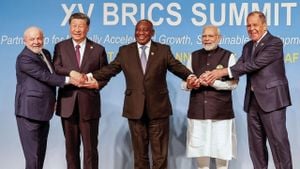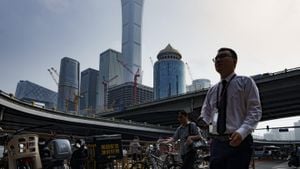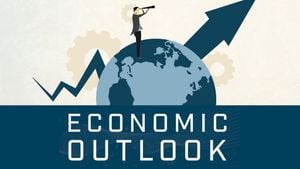Iran's economic climate remains troubled as inflation statistics released for October reveal a point-to-point inflation rate of approximately 31.6%, significantly exceeding the government’s target of 25% for 2024. This persistent inflation is undermining the ambitions of government officials who are struggling to rein it back. Earlier this year, inflation hit its lowest point at 31% in April, providing what seemed like hope for stabilization. Alas, recent data shows inflation creeping back up, complicate the country’s economic outlook.
Shockingly, the monthly inflation rate had experienced consistent declines since June, but this trend took an unexpected twist recently with the figures indicating significant inflationary pressures. This uptick occurs just when the Iranian parliament is gearing up to evaluate the budget for 2025. The rising inflation not only complicates the government’s economic strategies but also amplifies the challenges related to planned salary increases for government employees.
Experts highlight the considerable budget deficit and soaring exchange rates as major hurdles to improving and controlling inflation. The Iranian administration’s commitment to achieving ambitious goals outlined in its 7th Development Plan is increasingly being viewed as unrealistic within the current framework. The plan aims at facilitating 8% economic growth and bringing inflation down to single digits — lofty targets under the present economic conditions.
The proposed budget for 2025 suggests troubling financial forecasts, hinting at the possibility of deficits reaching as high as 800 trillion tomans. The Iranian government is expected to manage this through bond sales and borrowing from the central bank, methods which can, unfortunately, exacerbate inflation even more. Experts are particularly concerned about the 175% increase seen recently in bond issuances, which will require higher interest rates to attract potential investors, potentially leading to more strain on Iran's already fragile capital market.
Interestingly, the budget plan also introduces the possibility of transitioning to a floating exchange rate for basic commodities. This departure from the current fixed rate of 31,000 tomans per euro raises fears of increased inflation, with predictions showing the exchange rate could shoot well above 50,000 tomans. Such drastic changes would directly affect the prices of basic goods, placing additional economic strain on the nation’s most vulnerable populations.
The government's forecast includes expectations of oil revenues rising by 41%, but there is significant skepticism due to the 20% gap between projected revenue growth and exchange rate inflation. The ambitious borrowing plans, which include of $10 billion from the National Development Fund, may also lead to inflationary pressures, compounding the issues.
Tax revenue projections are also on the rise, with the government speculating 40% increases. But the fear is this might not go hand-in-hand with sufficient tax relief for businesses, risk overshadowing any improvements seen within the manufacturing sector and potentially driving unemployment higher.
Despite public budget growth reaching staggering levels of 130%, the Iranian government appears reluctant to undertake any cost-cutting measures or to reform spending practices. Instead, the 2025 budget reveals plans to increase public spending from 2.8 trillion tomans to 6.4 trillion tomans, indicating there may be little effort to address underlying issues of budget deficits, inflation, or stagnation.
With inflation averaging about 45% over the last three years, it is ill-fated to think Iran can achieve its targeted single-digit inflation without considerable reform. Economic forecasts suggest continued challenges loom, not just with rising inflation but also with stagnation and fluctuations within financial markets as the proposed 2025 budget sets the stage for another year of prolonged economic difficulty for the Iranian populace.
Meanwhile, as the situation intensifies, the Reserve Bank of Australia (RBA) has also been feeling pressures of its own as it gears up for its next monetary policy move amid growing concerns about inflation. With the RBA's November meeting just around the corner, economists are anticipating the release of updated inflation figures which many believe will impact predictions for interest rate changes.
The Australian Bureau of Statistics plans to release Consumer Price Index (CPI) data soon, and the news is much awaited. The June quarter saw CPI increase by 3.8% on a yearly basis, but recent government cost-of-living support, particularly energy rebates, is predicted to alter this trend dramatically. Economists from CBA have forecasted headline inflation might slow down to 2.9% for the September quarter, which can shift the perspective on interest rates going forward.
The RBA will also pay close attention to various releases and key economic events to determine their inflation strategy. The preliminary data indicates signs of improvement, but many stakeholders remain cautious about committing to bold predictions just yet. Also, as part of their regular assessment, RBA representatives will be making public addresses about inflation trends, giving more insight as the AGM season approaches, and companies, including Tesla, deliver their financial reports.
Looking at the U.S. economy, Vice President Kamala Harris stands as the presidential candidate who can benefit from current economic indicators, with less than two weeks remaining until the elections. Signs suggest the economy—improving gas prices, falling mortgage rates, and increased inflation-adjusted incomes—seems to bolster Harris' campaign, which proponents argue should give her the edge.
Yet it does not automatically equate to victory, as voter perceptions can sometimes paint different pictures than what the statistics relay. While many traditional indicators hint at Harris’ favor, polls show voters still expressing confidence in former President Donald Trump’s ability to manage the economy, shaped largely by memories of the COVID-induced economic disaster.
Despite the overall inflation rates easing from the staggering highs of earlier periods, many Americans still feel the weight of higher prices, impacting their overall economic outlook. Moody’s Analytics reminded its audience how instances of inflation have affected public sentiment—underscoring fears about costs potentially swaying votes against the incumbent party, even if economic indicators favor them.
Fuel prices have seen one of the most noticeable declines as regular unleaded gas now hovers around $3.15, down from $5 over the summer months of 2022, likely giving consumers renewed hope for stability. Meanwhile, mortgage rates have begun to fluctuate, currently averaging around 6.44%, creating mixed sentiments about housing affordability—an important issue for many voters.
Inflation-adjusted incomes showcase some gains, as average incomes witness growth of about 1.8%, yet concerns persist. Consumer confidence witnessed its largest drop over the past three years, signifying people’s anxieties around economic stability, hinting how pivotal public sentiment will be as Election Day approaches. With Harris currently holding slight leads against Trump, the election’s tight nature manifests varying predictions—each hinging primarily on how either candidate can mobilize voter support surrounding the pivotal issues of inflation and economic recovery.
Remarkably, polling data reveals challenging conversations for voters, with significant populations expressing discontent with how they perceive the economy and their circumstances under current leadership. Tensions around inflation paired with other looming issues forecast uncertainty continues to be the focal point to observe, especially as each candidate positions their responses to these economic realities.”}



